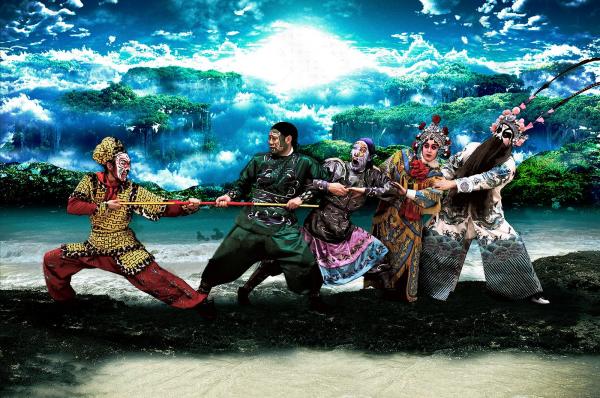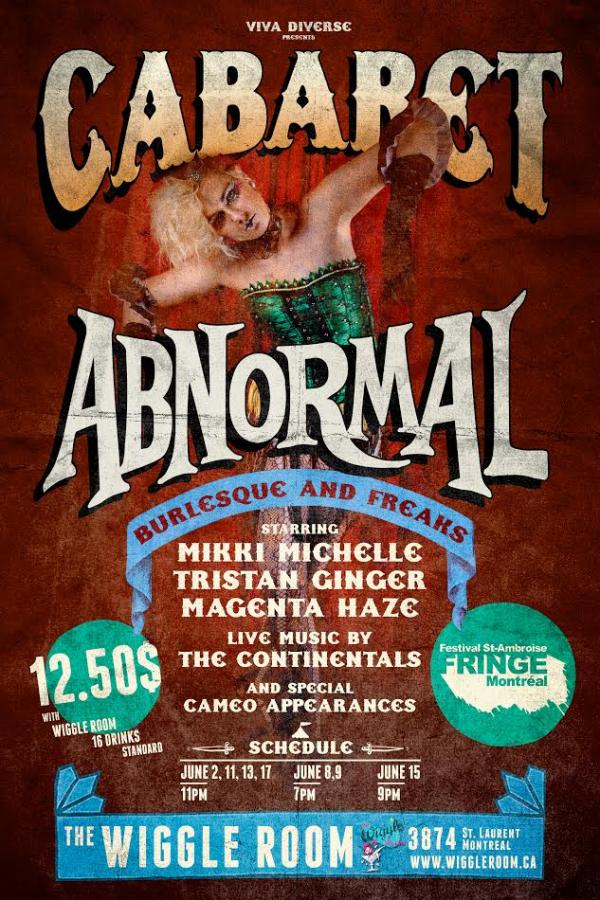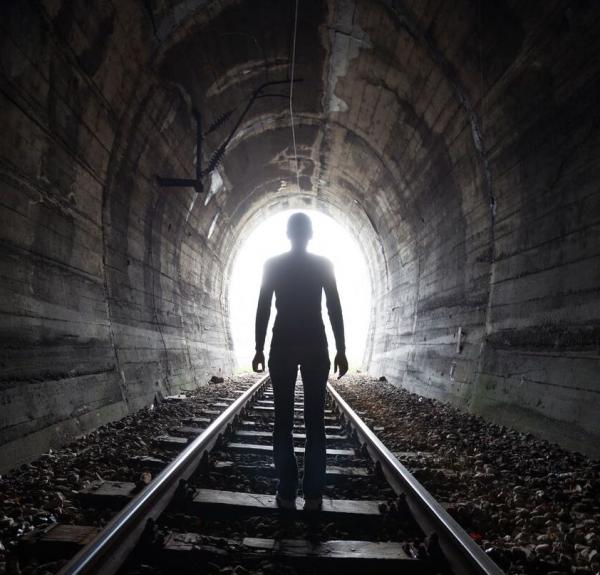RSS
FRINGE 2017: Berlin Waltz, Telling History Through Music

Berlin Waltz is a riveting dance across the city which faced so much controversy and hardship during the Cold War. It is a brilliant, fun story of Devon More’s bike ride along what used to be the Berlin Wall, as she discovered the history of why the wall was put up, what East and West Berlin were like for the 28 years that the city was divided, and why and how the wall fell. Her adventure came to life through her storytelling and her music in this captivating one-woman show.
The show begins with a waltz, carefully constructed as the audience comes in. Those paying attention get a glimpse of her prowess with ukulele, flute, multiple percussions, and loop pedal, not to mention her creativity and excellence in song writing. Over the course of the show, she builds several songs from the bottom up, layering simple melodies on top of one another, creating incredible songs bit by bit while she tells her tale. Her story drifts seamlessly from spoken word to song; a powerful story told with a powerful voice—strong when spoken and jaw-droppingly sexy when sung. The entire performance is beyond captivating and incredibly immersive.
Despite the heavy topic, More keeps the show light and fun. She uses sock puppets and over-the-top gestures to tell her tale, she keeps the lyrics to her songs sarcastic and the songs themselves sound deceivingly happy. It is an ingenious way to portray history for people that wish to accept the horror in their own time, and to help those unfamiliar with the truth ease into their own realization. At the same time, for those who have studied this branch of history, the songs are ironic and sardonic. It’s rare to encounter such versatility of interpretation within single pieces of music, and is a further testament to More’s brilliance.
Audience participation, so often either loved or hated with little middle ground, is a part of a show that can derail everything if the audience is unwilling. More’s execution of her song requiring audience participation was as smooth and successful as I’ve ever seen. Even the transition into this segment, harshly unplugging her ukulele at the just the right moment, exuded perfection. She walked through the audience asking members to stand up and act as elements of the wall itself, describing what their role is in the monstrosity of division. The effect it created was shocking, powerful, and eye-opening.
This entire piece is brilliant and beautiful beyond words. It is emotional, passionate, and well-paced with moving stories, inspiring music, and heartbreaking history. The stories and songs were thought-provoking and intense, and so well-crafted that the entire show was completely seamless. Each transition from song to spoken word, segment to segment, was perfectly timed and so incredibly tight that it gave the impression of looseness and improvisation. Aesthetically, the show was beautiful, partially because of More’s elegance and grace, partially because of how the stage was set paired with the profound projections that played throughout the piece. I highly recommend this show to anyone and everyone—whether or not you like music and storytelling, if you study history or you need to brush up on some facts. This show is a work of art.
FRINGE 2017: One Too Many Brings Poignant Narrative

One Too Many is a two-person play rife with symbolism and inner reflection. It challenges the way we look at excessive alcohol consumption and questions our behaviour once we’ve had one too many drinks. Based on their life and experiences, Evan and Calla confront their own complicated relationships with alcohol and explore their varying alcohol dependencies with the audience. It is a must-see if you want to better understand the struggle of substance abusers.
Having been lucky enough to discuss the play with the artists, I can provide some insight into their thought process, their vision and their message (ATTENTION: spoilers ahead!).
The play is structured in four parts, and is based around the four stages of dependency and the four stages of inebriation. Between each section, we hear of the next stage of inebriation along with a scientific explanation about what physical state the performers are experiencing. Following these explanations, the performers enact scenes representative of their own alcohol dependency and their friendship that has remained strong throughout.
In part one, they each build what they call “memory towers” out of the classic red and blue plastic cups traditionally used for beer pong. Each cup is adorned with a memory of something they have shared or endured together during the course of their friendship and every time a tower is knocked down, the tower-toppler must take a shot of gin while the other rebuilds it. This rule continues through the show, allowing them to actively choose to drink over preserving their own memories.
Part two was a fun game of Pictionary! Three rounds were played with the audience where, if the drawing was not guessed correctly, the artist would be required to take a shot. This power-play with the audience highlighted the concept that social drinking can sometimes put the number of drinks one has into the hands of someone other than yourself and was masterfully paired with the concept that failure is inevitable after enough drinks.
The two interludes that accompanied part two evolved from puns. Evan had to literally hold his liquor as he balanced partially filled plastic cups on his out-stretched arms and head. It was an elegant demonstration of having to function normally while carrying the burden that too many drinks can bring. On a similar concept, Calla performed a literal interpretation of cotton mouth by placing gin-soaked cotton balls in her mouth while reciting a monologue. This continued as long as she could tolerate it and ended with her throwing them up into a bucket. The lack of subtly made this part particularly poignant. Drinking until one vomits is not uncommon, but seeing it displayed like this drives home the fact that drinking to that point is self-inflicted.
Part three became more violent and harsh. It was built on the recklessness of drinking to excess and the carelessness with which people handle their own health. Eggs representing the fragility of common sense were gruesomely filled with fragments of what looked like human brains and carelessly tossed back and forth. Once the first one was dropped and smashed to pieces, the rest were ruthlessly given as a sacrifice to the domination of alcohol dependency.
The final part was an enactment of the vicious circle that is the dependency of alcohol. They stripped naked, hiding nothing from the oppressiveness of their alcoholism, and bathed in its nectar. This act of cleansing, this statement of starting over, was negated by the contamination of their purifying agent. It was a compelling way of saying that the road to freedom is so often paved with what you are trying to escape.
FRINGE 2017: The Monkey King Gets HIs Staff

Chinese Opera is an art form which I know very little about. However, like I always say about classical music, you don’t need to know a lot about something to appreciate and enjoy it. Trust me when I say that there is a lot to appreciate and enjoy about the fantastic, funny, incredibly impressive performance put on by Jing Ju Canada.
The show opened with some outstanding dance performances showcasing the traditional Chinese style of dance. The performers were fluid and graceful and the choreography was interesting and well done. More often than not, when there were multiple people dancing onstage at once, each individual was doing something completely different. The effect that this created overall was beautiful and captivating. Each dance seemed to tell a story, be it the interplay of the 4 elements, or the crushing heartbreak of lost love, such as the case of the passionate solo umbrella dance.
The Monkey King Gets His Staff told the story of the Monkey King. As the story goes, he learned a number of arts from Buddhist monks and he was an extremely gifted student. However, he did not have an adequate weapon to fight with, so he endeavoured to borrow one from the Dragon King, who was famed for his expansive armoury. This story was told through light-hearted comedy, elaborate costumes and makeup, and incredible acrobatics. The storyline acted as a foundation on which the performers could enact fantastic fight scenes using martial arts, swords, staves, hammers and more. Each fight was more elaborate and impressive than the ones that came before and each performer revealed an outstanding amount of mastery and skill on a number of weapons.
I would recommend this show whether you’re familiar with Chinese Opera or not. It was funny, captivating and beautiful, and an excellent chance to see a part of a culture that you may not know much about. The skill of each performer goes beyond what I can put into words, and the costumes and video projection sets were outstandingly beautiful. Who knows, maybe their show will even inspire you to go on adventures and find a staff of your own!
FRINGE 2017: CABARET ABNORMAL: KOOKY, SEXY FUN

Cabaret Abnormal is a mysterious showcase of Montreal’s sexiest burlesque and circus performers! Organized by Viva Diverse Productions, Cabaret Abnormal stars director and dark beauty Mikki Michelle, the madly alluring Magenta Haze, and the dangerously beautiful Tristan Ginger! With live jazz music by Elias Halwaji and The Continentals, Cabaret Abnormal quite literally steps out of the box to give you a give you a night of kooky, sexy fun!
Mikki Michelle, Magenta Haze, Tristan Ginger and special guest Natasha Nebula completely captivated the audience at The Wiggle Room. Every performance was more dangerous than the next, with Natasha bringing out a live snake for her show-stopping cameo! Natasha was gorgeous and courageous and had the entire audience at the edge of their seats during her snake dance.
Elias Halwaji was a talented singer and hilarious host, handling hecklers and maintaining the show’s smooth, sultry atmosphere between performances. Elias and The Continentals did an outstanding cover of Under Pressure as well as some of their own original songs. The Continentals were amusing and a pleasure to watch!
The mysterious and charming Mikki Michelle had amazing chemistry with her fellow artists. You could really see how much all of her performers adored and trusted her during each delightfully risky act! Mikki was a great hostess and it was wonderful to be able to see her legendary cabaret!
Magenta Haze was a bloody mess in the best way possible and had the cutest performances in the cabaret! It was so much fun to watch Magenta interact with audience members and gracefully dance around The Wiggle Room! Magenta looked innocent and saintly in her iconic blue veil.
And Tristan Ginger performed beautifully and gracefully, as always! Tristan always wears elegantly and wildly creative costumes for his performances. It was also deeply inspiring to watch Tristan challenge cultural and societal norms to create enchanting, breathtaking burlesque!
Cabaret Abnormal is an incredible showcase of Montreal’s best performers! Check it out from June 2nd to 17th at The Wiggle Room located at 3874 Blvd. St. Laurent, Montreal!
Patricia Petit Liang is part of CJLO’s Official Fringe Team covering the sights and sounds from the 2017 St-Ambroise Montreal Fringe Festival. She also hosts Fatal Attraction every Thursday from 12pm – 1pm, only on 1690AM in Montreal and online at CJLO.com.
NEWS FOR WEDNESDAY, JUNE 14TH 2017
Hosted by Patricia Petit Liang
Stories by Allison O'Reilly and Patricia Petit Liang
Produced by Patricia Petit Liang
-------------------------------------------------------------------------------------------------------
LOCAL
By Allison O’Reilly
Recent statistics show an increase in hate crimes in Montreal, particularly against the Muslim community.
According to CBC News, Statistics Canada says the numbers presented likely underreport “the true extent of hate crimes in Canada, as not all crimes are reported to the police.”
Statistics Canada says 29 more incidents were reported in 2015, for a total of 169 crimes, marking a 29 percent increase over the previous year.
NATIONAL
By Patricia Petit Liang
3 people were killed in a murder-suicide while camping on Tuesday.
According to CBC News, the tragedy unfolded at the Club Naturiste Adam & Eve in Sainte-Brigitte-des-Saults.
Suspected shooter 76 year old Denys Carpentier was found dead at the scene and police are still investigating the incident.
INTERNATIONAL
By Patricia Petit Liang
More than 90 people were killed by landslides in Bangladesh on Tuesday.
According to Reuters, the landslides were caused by heavy rains.
The death toll will most likely continue to rise as rescuers search for dozens of missing people.
FRINGE 2017: Pounding Nails In the Floor With My Forehead

Lately, I’ve been waking up to feelings of helplessness and nihilism as my clock radio reminds me that I’m living in the age of Trump. I try to calm myself down by turning to the comedic monologues of late night talk shows, but the jokes have become repetitive. It makes me yearn for something with more substance, with more of a human touch. I need something that can stand the test of time, not just dabble in week-to-week politics.
This is why I believe local comedian Karl Knox chose to direct Eric Bogosian’s Pounding Nails In the Floor With My Forehead for this year’s Montreal Fringe Festival. Knox dug into the past and pulled out a script written in 1994 as a way of commenting on the current state of America, much like how Arthur Miller used the Salem witch trials in response to McCarthyism.
Pounding Nails is a collection of soliloquies delivered by a colourful cast of characters, some more relatable than others. Each character has felt bogged down by social norms to the point where they can no longer remain silent. Some seek comfort in support groups or grocery shopping, while others foam at the mouth with rage or fall to their knees cursing the very ground they walk on.
Knox opens the show with a nightmarish rant as a right-wing radio host; a role he slips into comfortably, being the real life host of CJLO’s Your Media Sucks! Knox returns to the stage later on as a middle-class optimist, staring pensively at his half-full pint of beer.
A standout performance was done by Dan Derkson as the Vietnam veteran-turned-drug dealer, Red. Derkson shares stories of wilder, simpler times, punctuated with maniacal laughter. But behind his bug-eyed enthusiasm are subtle hints of loneliness.
There was the noticeable absence of comedian Rodney Ramsey, one of the many reasons why I was drawn to this production. But his role as a “recovering male” was taken over by Ladies and Gentlemen co-host Daniel Carin, who brought a sense vulnerability and sheepishness to the character.
Throughout, the modestly-sized audience was either roaring with riotous laughter or dead silent, giving gravity to the ideas presented to them.
Between scenes, burlesque performer Shauna Feldman (or you might know her alter-ego, Elle Diabloe) sensually changed title cards and was complimented with hoots and whistles from the audience. Feldman closed the show by repeatedly telling society to “Blow me” in a monologue originally intended for a male actor. Despite this show of gender inclusion, my date felt that the production was still very “male-centric,” considering the emphasis on ejaculation in more than one monologue. This is a detail that couldn’t be helped since the script needed to be kept in its original form. Consequently, many out-of-date pop culture references flew over my head, since I was only a toddler at the time Bogosian wrote the play. Nevertheless, I still believe in the importance of thought-provoking theatre, especially today. If you’re looking for a remedy for your modern age blues, I recommend you head to the Wiggle Room to catch the final performances of Pounding Nails.
NEWS FOR MONDAY, JUNE 12TH 2017
Hosted by Patricia Petit Liang
Stories by Karl Knox, Jeremiah Ho, and Patricia Petit Liang
Produced by Patricia Petit Liang
-------------------------------------------------------------------------------------------------------
LOCAL
By Jeremiah Ho
3 people were fatally stabbed in the Northern Quebec Inuit village of Akulivik on Saturday.
According to CBC News, police shot and killed 19-year-old suspect Illutak Anautak as he attempted to break into another home.
2 survivors were transported with critical injuries to a Montreal hospital.
LOCAL
By Patricia Petit Liang
Homeless outreach group Accueil Bonneau and urban beekeeping company Alvéole have teamed up to teach beekeeping to homeless men in Montreal.
According to CBC News, the 2 companies have created a beekeeping program to teach homeless men ages 25 and up job skills, to encourage social interaction and to save the environment.
The companies have 60 beehives in 7 different locations around the city.
INTERNATIONAL
By Karl Knox
Qatar is pursuing diplomatic channels in an attempt to end current sanctions from its former allies Saudi Arabia, the United Arab Emirates, Egypt and Bahrain.
According to Reuters, the sanctions include a halt to all land, air and sea traffic, the ejection of diplomats and the ordering Qatari citizens to leave all Gulf states within 14 days.
Qatar’s former allies have accused the country of supporting Iran and terrorism.
FRINGE 2017: The Detective, The Dame and The Devil

Jazz music, incessant cigarette smoking, murder—this piece of detective fiction has it all! Everything that comes to mind from a murder mystery set in the 20s, right down to the pinstriped suites and showgirls, The Detective, The Dame and The Devil has it. What it also has in addition to your standard detective story staples are lame puns, cheap gags, and running jokes that give the whole show fantastic continuity. It was perfect. Small details revealed at the beginning of the show were easy to pass off as mere silliness, but so often they would tie into the plot in unexpected and incredibly silly ways, making the whole show completely hilarious and impressively well thought out. Throw in some plot twists and we have a winner!
The story itself is fairly simple, not very complex. There’s not actually a lot of mystery to the murder, no following the footsteps of an autistic genius detective and his ex-military companion as they scour for clues with inhuman powers of observation. Instead, the story is laid out plainly in front of us with clear, easy-to-follow details, until an unexpected plot twist elevates the intrigue of the play to the same level as its comedic mastery. We are then taken through the story again, this time walking through the shoes of another character.
This is where the brilliance of the play really begins to shine. We’re shown the same 12-odd hours from the point of view of the 3 characters in turn; first the detective, then the dame, and finally the devil. Each time we watch the same day unfold before us, the characters that we just got to know change, sometimes becoming themselves through their own eyes, sometimes transforming into the people that one of the other two see them as. The variations these characters evolve through are staggering. Even as each character is re-revealed, the attention to detail in their costumes is just as impressive as the changes in their personality. Small things like the length of a neck-tie or a glittery handbag are like rings on a pond—extending further and more subtly than is easily perceived.
The costumes weren’t the only details that exuded mastery in the performance—the set itself was a work of brilliance. There were three places that we saw on stage: the detective’s office, a jazz club, and a warehouse. Each time we saw the same scenes played out from different perspectives, the orientation of the set changed to match the change in perspective based on which character was narrating. It really helped to illustrate what is possibly the underlying message of the play: a thought-provoking commentary on seeing the world from perspectives other than your own. Either that, or it was a chance to make as many jokes as possible in an hour. Regardless, it was an undeniably brilliant work of comedy, mystery, satire and silliness and it is well worth adding to your list of shows to see this year.
FRINGE 2017: Memento Mori Surpasses Expectations

What an experience.
I’ve been to many shows over the years, where walking into the performance space feels like you’re stepping into another world, but not like this. This was more of an experience than a piece of theatre.
Before I continue, I need to disclose my relationship with Trevor Barrette, the writer, director, and one of the actors of the play. We are friends. However, I feel that our friendship will not greatly bias my impression of this piece since I only extended an arm of friendship to him after seeing To Be and Captain Aurora 1. I did so out of love for those productions and the desire to get to know someone whose skill I admire, and who I truly believe to a genius (Memento Mori being another example said brilliance). For what it’s worth, we have had a predominantly working relationship so far.
Walking into a room where you’re going to see a play, but seeing a circle of chairs in lieu of a stage, is a bit of a surprise. Being offered tea and biscuits upon entering is an additional, very pleasant surprise. To sit down in such a space and be given a name tag and a handout is a very interesting, unique way to start a play—its design is inherently immersive, because you are surrounded by people with name tags like yours. Other than the kind soul greeting you at the door, you have no way of knowing who the actors are, or where action of the play is going to come from.
Essentially, this play was composed of a series of monologues, each one depicting a story about why the deceased person was there. Not just there at the meeting, but there in the afterlife. It’s built on the concept that unfinished business and unresolved feelings prevents souls from leaving this plane of existence for another, so this meeting you’ve joined was a chance for the dearly departed to discuss their own deaths, confront the burden of causality and get closer to making peace with their pasts.
Once everyone was seated comfortably the meeting began. It started with stories and thoughts, individuals opening up a little bit at a time. Some of them were open about why they were there, some of them had a harder time accepting it. As each person spoke, they didn’t just share their stories, they relived them. They brought their pasts, their lives, into the room. Their worlds grew out of their words, slowly creeping in and surrounding everyone, infiltrating our thoughts and feelings, little by little, quietly taking over our memories as if we were the ones speaking, as if perhaps we were the ones who had died that way. Until finally, the rogue worlds opened up and swallowed everyone there—every moment, every thought, every sound, each tear, each heartbeat—alive again, the only thing that ever has or ever will exist.
But then they stop speaking and their world fades and your world returns, and you remember who you are, and you remember that you’re dead, and that even though you are surrounded by souls, you are utterly alone.
Review: True to Self by Bryson Tiller

After a fantastic debut with his breakthrough album TRAPSOUL in 2015, which managed to reach platinum status, Bryson Tiller released his long awaited follow-up album True To Self. Although the R&B singer had initial plans of releasing the album in June, he gave an explanation as to why it the album was released a whole month early in an interview with Billboard. The artist stated, "I can't take the credit for that. It was just my manager, it was his plan [to] drop it a month early." The album's early release took many by surprise with its unexpected drop, but having had time to go on multiple tours, and to get feedback from fans as to what they liked and what they wanted, this album tries to satisfy everyone. From the fans of TRAPSOUL to those who preferred the work of the mainstream scene, True To Self tries to do this with a hefty 19-track production.
The project spans an hour long providing many R&B tracks displaying Tiller’s singing capabilities, alongside a couple rap tracks where he displays his diversity as both a rapper and R&B singer.
Many of his R&B tracks tend to speak on the matters of his relationships with different women throughout his life, especially after the success of TRAPSOUL and having performed a series of live shows. In his first track "No Longer Friends", there's dialogue which can be heard between a girl and what sounds like her boyfriend, where the two are arguing over her having, and possibly displaying, feelings for Tiller. She's being accused of seeing him while being with her boyfriend, but she tries to mask Tiller as "her brother." Even in one of his later R&B tracks, "In Check", Bryson gave the following rhyme as his reason for the album taking so long to be made: "Album overdue| You would find it hard to focus too| If you met the women I have| Hard not to get sidetracked." He also shows and expresses himself to another girl, who apparently smokes and drinks often, by saying "I'm the only drug you need to get you through it" in the chorus of "Don't Get Too High."
True To Self also delivers Bryson's first released attempt at making an afrobeat-styled song with "Run Me Dry." With fellow artists like artists Drake and Tory Lanez, to name a few, who've also taken a similar route at some point, Tiller, unlike the others, took a more melodic tone with this track. It delivers a more rhythmic and relaxed vibe to it, yet it's still very capable of being a good party starter.
In "Blowing Smoke" however, there's no real sense of creativity in the lyrical structure of the song. Attempting to once again blur the lines of singer and rapper, Tiller provides a catchy chorus, but verses that aren't really anything for taking notes as inspiration for your next mixtape. What is really worth checking out is "Money Problems/Benz Truck." Being one of the one of the better tracks on the album, it delivers both lyrically and melodically. This is something worth the 5-minute run time, offering something worthy of car stereo blazing for sure. Add to that a DJ scratch near the end of the song, it just makes the track more entertaining and interesting.
Tracks such as "Teach Me a Lesson" and "Something Tells Me," alongside the many other R&B works found on the album, are Tiller's way of reclaiming himself as an R&B artist, taking a more 90s approach to them.
From listening to this album, one can tell that Bryson's latest work is more so catered towards appealing to a much larger and more mainstream audience than those who've praised his work and sat by desperately awaiting this album to drop. With tracks like "Run Me Dry" and "Blowing Smoke" it's pretty clear to see that.
Although the album has some noteworthy tracks, it's hard to say that this album was something extremely different to what's already out there by other artists. However, it's fair to say that this can be due to the current album's highly praised predecessor, alongside True To Self's heavy track weight, and its high anticipation due to Tiller's almost two year hiatus, that really caused this album to not be accepted as something amazing, but still appreciated.



